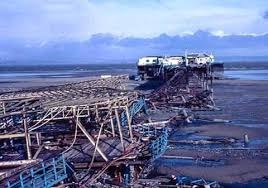
Memories from the 1950s of some of Heysham’s tea gardens (popular with holidaymakers from Morecambe) were passed on earlier this year by Liz Bryan of Grange U3A.
There were three tea gardens facing a row of cottages. My job was with one owned by the Haddath family and, at the time I worked there as a weekend/school holiday waitress, it was run by Mr and Mrs Henderson, the daughter and son-in-law of the Haddaths. A lovely family, excessively busy but gentle with their guests and their employees.
Visitors who walked up the prom from Morecambe for a salad tea and famous custard tart were mainly from the wakes weeks holiday crowds, sometimes from Scotland, more often from the Lancashire cotton mill towns. One week they would be from Nelson, another from Colne, Burnley, or neighbouring towns.
The Haddaths’ garden was nearest the shore, overlooking the rocky beach and the whole of Morecambe Bay. Wooden tables with benches were set outside and there was a large, glass-walled conservatory with indoor seating. My neighbour, Kath, and I arrived on our bikes from 12 noon. We reported to the cottage where the living room was given over to a large wooden table which was filled with empty white pottery plates ready for the orders to come in as people arrived. Huge bowls of salad leaves, tomatoes, shelled boiled eggs, and cooked new potatoes were standing by. Mrs Henderson and her mother-in-law would be in the scullery/kitchen, buttering mountains of brown and white bread. Kettles were simmering and cups and saucers were piled at the ready. We donned aprons and washed our hands, then filled up small milk jugs from a large jug of milk, and salad cream pots from a big jar of Heinz Salad Cream.
As people strolled in, Kath, another friend, Sheila, and I took orders for meals and walked back to the cottage door. The choices of salads were egg, chicken, salmon (from the Lune) and roast ham. It was so soon after the Second World War and food like these meals was never served at home. The sizes of the meat portions were generous to say the least, and more often than not, hard boiled eggs were included with all choices. I have no memory of rubber gloves being used to serve the meat but all was performed in a very hygienic manner.
The Haddaths kept their live chickens in the field around my home garden along with horses that in summer months pulled landaus along Morecambe promenade.
Meals were seven shillings and sixpence, and massive slices of large round home-baked egg custards were extra (but worth every penny). Tea, coffee and lemonade were offered. We took the money (always cash) to, and got change from, a china bowl on a sideboard – which, by the end of each afternoon was piled high with ten shilling and pound notes and lots of ‘silver’.
We were paid fine shillings an afternoon, but were also given a meal the same size for which the visitors had been paying – worth the happy labour if no wages had been paid. We sat and ate outside or in, where the visitors, long gone, had been sitting earlier. We stayed to fill salt, pepper and sugar containers. Other people did all the washing up, by hand, in very hot water, and everything was rinsed. We had tips from customers and, at the end of each day, these were shared out to just the three of us. There was no work on rainy days so each day we had worked, we went home well fed and with our money in our pockets.
I remember one day there was a tragedy out on the Bay, not far from where we were working. A boy had overturned his canoe in the receding tide and he had drowned. He had been in my class at primary school a few years previously.
A busy, young Mrs Henderson with her own little girl of pre-school age at her feet, was rushed and responsible but never raised her voice or got flustered. She worked most efficiently. The overwhelming memory of the tea gardens for me is happiness.
MORECAMBEOLOGY LIVE IN HEYSHAM A guided walk, Hidden Heysham, will start from the bus turnaround in Heysham Village at 2pm this Saturday June 30. The walk includes rock carvings from the time of the Great War as well as memories of tea gardens, fairy grottoes and puppet superstars. Places on the walk are priced £3 per person. For further details contact the tour guide Peter Wade, telephone 01524 4209045.







